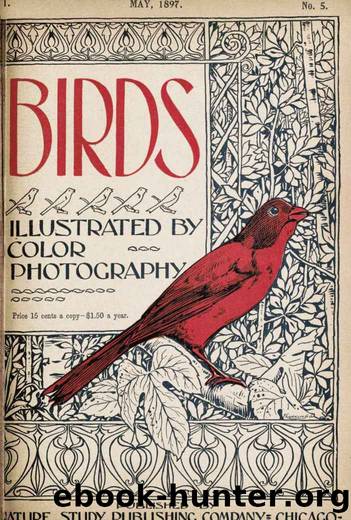Birds, Illustrated by Color Photography, Vol. 1, No. 5 May, 1897 by Various

Author:Various
Language: eng
Format: mobi
Tags: Zoological illustration -- Periodicals, Birds -- Periodicals, Natural history -- Periodicals
Published: 2008-07-06T00:00:00+00:00
night hawk.
3â5 Life-size.
From col. Chi. Acad. Sciences.
* * *
THE WOOD THRUSH.
âWith what a clear
And ravishing sweetness sang the plaintive Thrush;
I love to hear his delicate rich voice,
Chanting through all the gloomy day, when loud
Amid the trees is dropping the big rain,
And gray mists wrap the hill; foraye the sweeter
His song is when the day is sad and dark.â
O many common names has the Wood Thrush that he would seem to be quite well known to every one. Some call him the Bell Thrush, others Bell Bird, others again Wood Robin, and the French Canadians, who love his delicious song, Greve des Bois and Merle Taune. In spite of all this, however, and although a common species throughout the temperate portions of eastern North America, the Wood Thrush can hardly be said to be a well-known bird in the same sense as the Robin, the Catbird, or other more familiar species; âbut to every inhabitant of rural districts his song, at least, is known, since it is of such a character that no one with the slightest appreciation of harmony can fail to be impressed by it.â
Some writers maintain that the Wood Thrush has a song of a richer and more melodious tone than that of any other American bird; and that, did it possess continuity, would be incomparable.
Damp woodlands and shaded dells are favorite haunts of this Thrush, but on some occasions he will take up his residence in parks within large cities. He is not a shy bird, yet it is not often that he ventures far from the wild wood of his preference.
The nest is commonly built upon a horizontal branch of a low tree, from six to tenârarely much moreâfeet from the ground. The eggs are from three to five in number, of a uniform greenish color; thus, like the nest, resembling those of the Robin, except that they are smaller.
In spite of the fact that his name indicates his preference for the woods, we have seen this Thrush, in parks and gardens, his brown back and spotted breast making him unmistakable as he hops over the grass for a few yards, and pauses to detect the movement of a worm, seizing it vigorously a moment after.
He eats ripening fruits, especially strawberries and gooseberries, but no bird can or does destroy so many snails, and he is much less an enemy than a friend of the gardener. It would be well if our park commissioners would plant an occasional fruit treeâcherry, apple, and the likeâin the public parks, protecting them from the ravages of every one except the birds, for whose sole benefit they should be set aside. The trees would also serve a double purpose of ornament and use, and the youth who grow up in the city, and rarely ever see an orchard, would become familiar with the appearance of fruit trees. The birds would annually increase in numbers, as they would not only be attracted to the parks thereby, but they would build their nests and rear their young under far more favorable conditions than now exist.
Download
This site does not store any files on its server. We only index and link to content provided by other sites. Please contact the content providers to delete copyright contents if any and email us, we'll remove relevant links or contents immediately.
Evelina by Fanny Burney(26770)
Evelina, Or, the History of a Young Lady's Entrance into the World by Fanny Burney(26215)
Twilight of the Idols With the Antichrist and Ecce Homo by Friedrich Nietzsche(18475)
Pale Blue Dot by Carl Sagan(4883)
The Perks of Being a Wallflower by Stephen Chbosky(4548)
Dune 01 Dune by Frank Herbert(4288)
Double Down (Diary of a Wimpy Kid Book 11) by Jeff Kinney(4176)
Man and His Symbols by Carl Gustav Jung(4055)
Walking by Henry David Thoreau(3875)
Separate Beds by LaVyrle Spencer(3754)
Ficciones by Jorge Luis Borges(3550)
FOUNDATION AND EMPIRE by Isaac Asimov(3534)
The 101 Dalmatians by Dodie Smith(3438)
Mystery at School by Laura Lee Hope(3354)
Anna and the French Kiss by Stephanie Perkins(3303)
120 Days of Sodom by Marquis de Sade(3160)
Some Prefer Nettles by Tanizaki Junichiro(2825)
The Little Prince by Antoine de Saint-Exupéry(2813)
My Ántonia by Willa Cather(2729)
